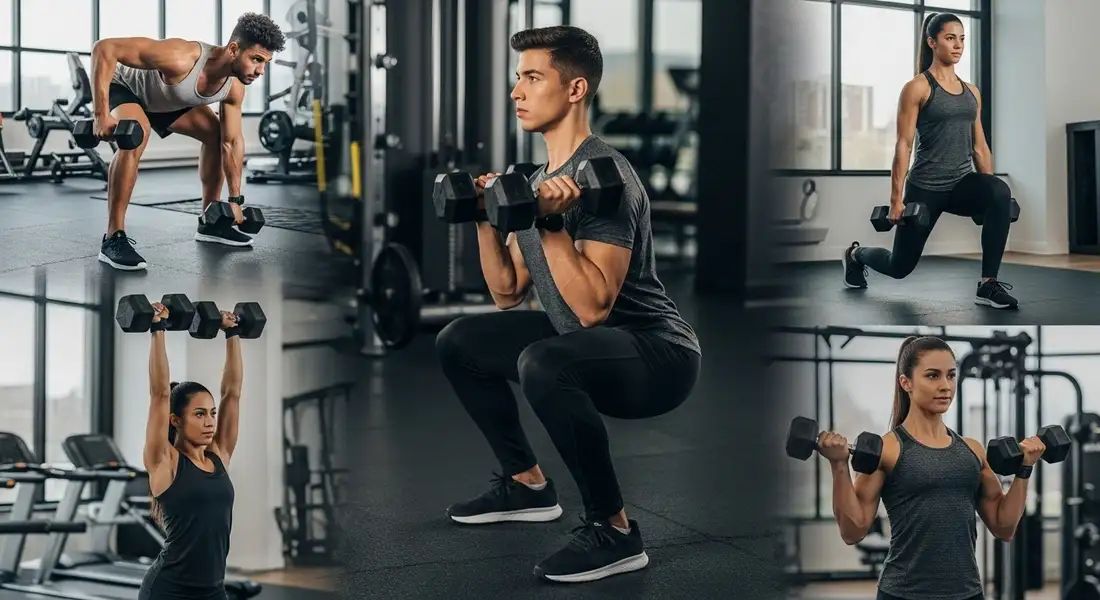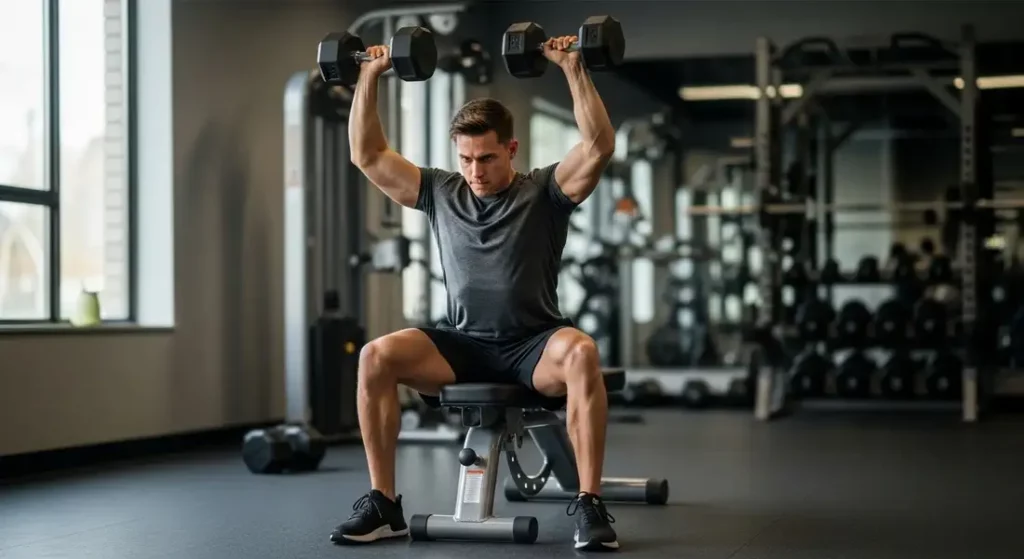Welcome to the most exciting part of your journey! You’ve done the research and picked out the perfect set of dumbbells.
Now, it’s time to put them to work.

This guide is your starting point for action, teaching you the five most essential beginner dumbbell exercises.
Why just five?
Because we believe in mastering the fundamentals.
These compound movements are the building blocks of strength.
They work multiple muscle groups at once, giving you the most effective, efficient full-body workout possible.
Focus on learning these movements with perfect form.
Once you do, you’ll have a powerful and effective routine you can do for life.
And remember, the most important page in this entire series is our guide on Proper Form and Safety with Free Weights.
Keep those principles in mind with every single rep you do.
Five Most Essential Beginner Dumbbell Exercises
1. The Dumbbell Goblet Squat (Legs, Glutes & Core)

Why It’s Essential: The Goblet Squat is the perfect way to learn squatting form. Holding the weight in front of your chest acts as a counterbalance, helping you keep your torso upright and teaching you the proper movement pattern safely.
Step-by-Step Instructions:
- Start Position: Stand with your feet slightly wider than shoulder-width apart, toes pointing slightly out. Hold one dumbbell vertically by one end, cupping it with both hands against your chest.
- The Movement: Brace your core, keep your chest up and back straight. Push your hips back and bend your knees as if you’re sitting in a chair. Lower yourself until your thighs are at least parallel to the floor.
- Return: Push through your heels to explode back up to the starting position, squeezing your glutes at the top.
Beginner Tip: Imagine you have a logo on your shirt and you want someone in front of you to be able to read it throughout the entire movement. This helps keep your chest from collapsing forward.
2. The Dumbbell Bent-Over Row (Back, Biceps & Shoulders)

Why It’s Essential: This is the ultimate back-builder. It strengthens your entire upper and lower back, improves your posture, and is the foundation for almost all other “pulling” exercises.
Step-by-Step Instructions:
- Start Position: Stand with your feet shoulder-width apart, holding a dumbbell in each hand with palms facing your body.
- The Hinge: Push your hips back and hinge at the waist until your torso is nearly parallel to the floor. Keep your back perfectly straight (no rounding!). Let the dumbbells hang straight down in front of you.
- The Row: Squeeze your shoulder blades together and pull the dumbbells up towards your ribcage. Keep your elbows tucked in close to your body.
- Return: Slowly lower the dumbbells back to the starting position with control.
Beginner Tip: Imagine you are trying to squeeze a pencil between your shoulder blades at the top of the movement. This ensures you are using your back muscles, not just your arms.
3. The Dumbbell Overhead Press (Shoulders, Triceps & Core)

Why It’s Essential: This is the best exercise for building strong, healthy shoulders. Performing it seated allows a beginner to focus on the pressing motion without worrying about balancing their lower body.
Step-by-Step Instructions:
- Start Position: Sit on a sturdy chair or bench with your back straight. Hold a dumbbell in each hand at shoulder height, with your palms facing forward and your elbows bent at a 90-degree angle.
- The Press: Brace your core. Press the dumbbells straight up overhead until your arms are fully extended but not locked.
- Return: Slowly lower the dumbbells back to the shoulder-height starting position with control.
Beginner Tip: Don’t flare your elbows out too wide. Keep them slightly in front of your body to protect your shoulder joints.
4. Dumbbell Lunges (Legs, Glutes & Balance)

Why It’s Essential: Lunges work one leg at a time (unilateral training), which is fantastic for improving balance, identifying muscle imbalances, and building functional strength.
Step-by-Step Instructions:
- Start Position: Stand up straight, holding a dumbbell in each hand at your sides.
- The Lunge: Take a controlled step forward with your right leg. Lower your hips until both of your knees are bent at a 90-degree angle. Your front knee should be directly above your ankle, and your back knee should be hovering just off the floor.
- Return: Push off your front foot to return to the starting position.
- Alternate: Repeat the movement with your left leg. That’s one rep.
Beginner Tip: Keep your core engaged and your torso upright throughout the movement. Don’t let your chest lean forward. If balance is an issue, practice the movement without weights first.
5. The Dumbbell Bicep Curl (Biceps)

Why It’s Essential: While the other exercises are big compound movements, the bicep curl is an isolation exercise that’s perfect for building arm strength and learning to feel a specific muscle work (the “mind-muscle connection”).
Step-by-Step Instructions:
- Start Position: Stand or sit tall, holding a dumbbell in each hand at your sides with your palms facing forward.
- The Curl: Keeping your elbows pinned to your sides, curl the weights up toward your shoulders by contracting your biceps.
- Squeeze: Squeeze your biceps at the top of the movement for a brief second.
- Return: Slowly lower the weights back to the starting position. Don’t just let them drop!
Beginner Tip: Do not swing your body to get the weight up! If you have to use momentum, the weight is too heavy. The only part of your body that should be moving is your forearm.
Key Takeaways – Your First Dumbbell Workout
- Master the Foundation: These five exercises (Squat, Row, Press, Lunge, Curl) create a balanced, full-body workout.
- Form Over Weight: The most important rule is to use perfect form. Start with very light weights, or no weight at all, to learn the movements correctly.
- Be Consistent: Aim to perform a full-body workout like this 2-3 times per week, with at least one rest day in between. Consistency is how you build results.
Frequently Asked Questions (FAQ)
1. How do I make a workout routine out of these?
A great starting point is to perform 3 sets of 8-12 reps for each exercise. For lunges, that means 8-12 reps per leg. Rest for 60-90 seconds between each set.
2. How do I know if the weight is right?
The weight is right if you can complete all your reps with good form, but the last 2-3 reps feel challenging. If you could easily do 5 more, it’s too light. If your form breaks down halfway through, it’s too heavy.
3. Do I need to warm up?
Yes, always! Before every workout, perform 5-10 minutes of light cardio (like jogging in place or jumping jacks) followed by dynamic stretches (like arm circles and leg swings) to get your body ready.
Conclusion
You’ve now got the core dumbbell movements down!
As you get stronger, you might get curious about the most powerful strength tool of all: the barbell.
Ready to learn more?
Read our next guide: Introduction to Barbell Training at Home (Safety First!) to see what the next step in your strength journey could look like.
